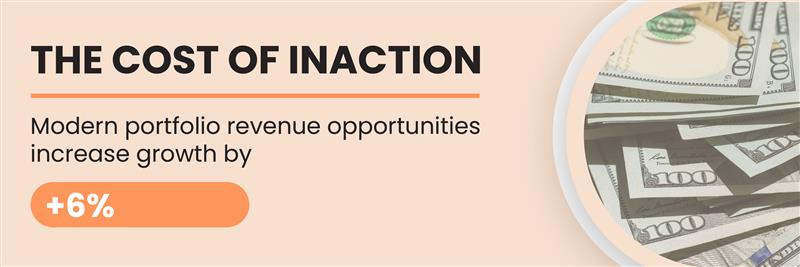Modern portfolio revenue opportunities increase growth rates by +6%

In today’s world, we have more information at our fingertips than ever before. However, one drawback of readily accessible information is the propensity to overanalyze, resulting in indecision or delayed action.
We’ve all heard the phrase, “the early bird gets the worm.” There are two ways to contextualize the “early bird.” The first is being the early mover. Being the first mover clearly has its advantages by focusing on greenfield opportunities. However, speed alone does not always yield the most efficient results, but yields results nonetheless. What if, instead of being the first to act, you were to act early and strategically? The commonality between the two contexts is action. The balance is in the efficiencies of data-driven decisions versus simply acting or activating change.
Due to the ever-evolving payments space, action is key. What is the cost of inaction? Some variables that require a responsive (or proactive) strategy include expected market conditions and forecasted spending changes, changes in merchant acquirer expense from regulatory changes, emerging competition and solutions, and merchant perception.

Lower forecasted volume growth, and the impact of inaction
Recent trends uncovered by TSG’s Acquiring Industry Metrics (AIM) platform suggest that positive 2021 influences will stabilize and result in lower merchant account size growth for 2022 – potentially low single-digit growth. With these headwinds, how are portfolio managers responding to hit revenue goals?
A retained account repricing effort can drive revenue, but each passing month without action represents a “cost” in the form of missed opportunities. In this case, the cost is derived from inaction.
- Using an example portfolio of 10,000 merchants, TSG estimates that ~30% (3,125) of a portfolio contains an actionable opportunity.
- Payments companies can expect to realize an additional $600 per merchant in revenue from each of the 3,125 merchants in the actionable group. Each month of inaction will cost $156,250 in missed opportunity.
- When viewed as an annual revenue increase, the amount represents a 6% improvement to the bottom line. That 6% could be the difference between above-market year-over-year growth or below-market growth.
Each month of inaction is a month without improvement to the bottom line. For portfolio managers looking to achieve above-market growth, take action now. Using a solution like Merchant-Level Analysis (related: Creating Opportunities at the Merchant Level), millions in new portfolio revenue opportunities can be uncovered in a few clicks as illustrated in the video below. Jump-start the process because as the saying goes… “the early bird gets the worm.”
Contact us today for a demo.
Demo: Merchant Level Analysis

By Josh Istas, Senior Director of Analytics